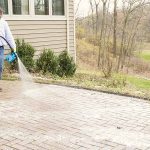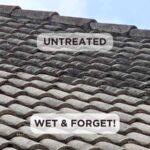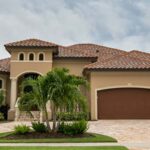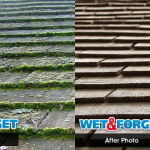What Are the Black Streaks on My Roof?
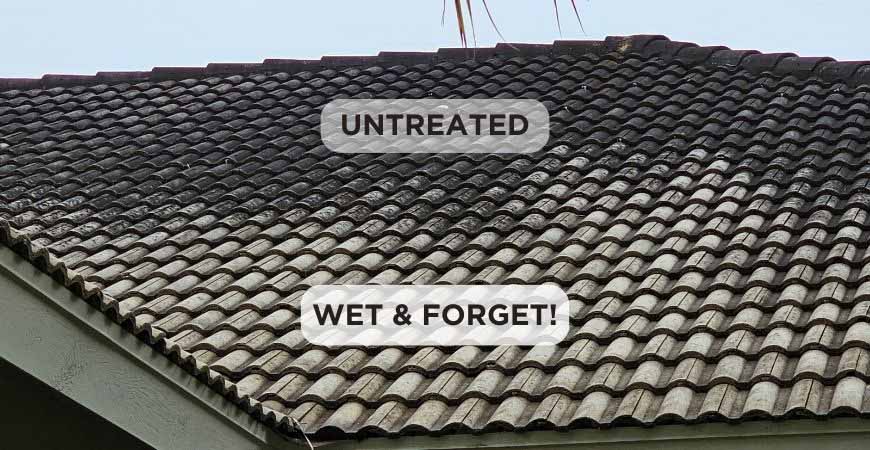
It is very frustrating when black streaks and stains appear on your roof, especially when you have no clue why they appear.
The appearance of the outside of your home is important. So why are there black stains on your roof, and how do you remove them?
Read on to find the answers to these questions and more.
What are these black streaks on my roof?
Algae commonly cause streaking and staining on roofs. The dark color that appears as a black stain is caused by a specific type of algae called gloeocapsa magma.
This growth is a type of bacteria that forms when algae spores group together. The Family Handyman explains that this specific type of algae is normally a blue or green color.
It can also appear to be a darker or black color on roofing and other surfaces. These dark colors help to protect the algae from the ultraviolet rays of the sun.

The organic growths may also appear as a stain or in a streaking pattern.
Algae grow best in darker conditions where there is moisture. Gloeocapsa magma algae typically grow on the north side of roofs, where there is less sun exposure throughout the day.
Like most bacteria, gloeocapsa magma grows best in environments where conditions are typically warm and humid. Warm and humid conditions are prominent year-round throughout the Southwest and Coastal regions, and seasonally in the Midwest regions of the United States.
Learn more about your area’s climate, and click here to learn more about why black streaks are on your roof.
How did algae get on my roof in the first place?
This type of algae spreads through the wind as it travels best through the air. Animals can also spread gloeocapsa magma.
If an animal was on one surface where they were in contact with spores of the algae and traveled to another surface, the spores could have traveled with them, and some could have been left behind on the new surface.
Airborne algae spores easily spread to rooftops close by each other. Because of this, oftentimes, more than one house in a neighborhood will have similar black streaks or stains on the rooftops.
If you start to see black streaks or stains appear on your roof, check to see if any of your neighbor’s roofs have a similar pattern on your next walk or drive around the block. It could help you determine if you do have gloeocapsa magma growing on your roof- and throughout your neighborhood!
Why are algae commonly seen on asphalt shingles?
In order to survive, bacterial growths need a source of food. The favorite food of gloeocapsa magma is limestone, a form of calcium carbonate. Limestone is often used in a crushed form for the fillers in between roof shingles.
Home advisor Bob Vila explains that limestone-based fillers are commonly used along with asphalt shingles. Asphalt shingles are a popular choice for roofing material because they are a rather inexpensive option than other materials.
Gloeocapsa magma commonly grows on asphalt shingle roofing because it eats away at the shingles’ limestone fillers.
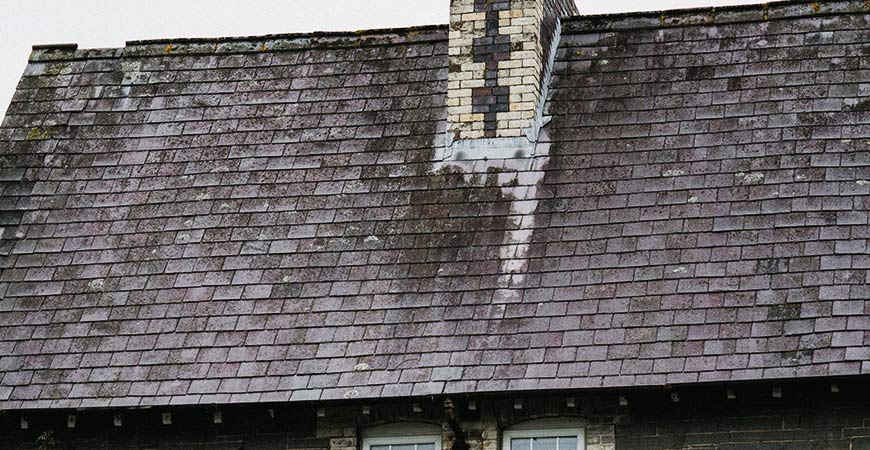
How can I prevent algae from regrowing on my roof?
Home improvement expert Danny Lipford says that you can prevent algae growth, including gloeocapsa magma, by installing strips of zinc or copper-coated sheet metals along your roof. These metals are toxic to organic materials, which will aid in preventing regrowth.
Although these metals do aid in preventing growth, they can be very expensive to purchase and maintain. The strips can also warp over time, which can reduce their effectiveness and cause a need for replacement.
Zinc and copper strips also need to be nailed into roofing to work properly. This can cause leaking in the future, so be careful if you decide to install metal strips on your roof.
You can also choose to install a metal roof since metal roofing does not require any additional fillers like those with limestone in them. The algae will have no food source and are less likely to survive on your roof.
Periodically removing any leaves or debris on your roof can help prevent algae growth as well. This way, there will be no excess moisture on your roof that debris could trap in.
If not addressed properly over time, the algae growth could form into a lichen and become even more difficult to remove. It is best to start addressing algae sooner rather than later to minimize any costly damage.
How do I remove the black streaks on my roof?
It is important to keep your roof clean. A clean and maintained roof helps to increase the lifespan of your roofing and keep the outside of your home looking nice.
The Wet & Forget Xtreme Reach™ Hose End product is the perfect solution to removing those pesky black stains. Easily reach the high areas of your roof without a ladder and with no scrubbing or pressure washing! The Xtreme Reach™ Hose End will help you quickly cover up to 2,000 square feet.
Wet & Forget’s gentle formula works with the wind and the rain and will remove any organic growth and the stains they have left behind over time.
When cleaning your roof, remember to remove any debris, such as leaves and twigs, from the surfaces. Debris can become wet or trap moisture, which algae, moss, and other types of organic growth thrive off.
Before using the Wet & Forget Outdoor products, make sure to thoroughly rinse any plants or landscaping with water before and after applying your product to protect them from browning.
To use the Wet & Forget Xtreme Reach™ Hose End Sprayer, connect any standard US garden hose to the Wet & Forget Xtreme Reach™ Hose End Nozzle. If you have a quick connector, make sure to remove it before attaching the Xtreme Reach™ Hose End Nozzle.
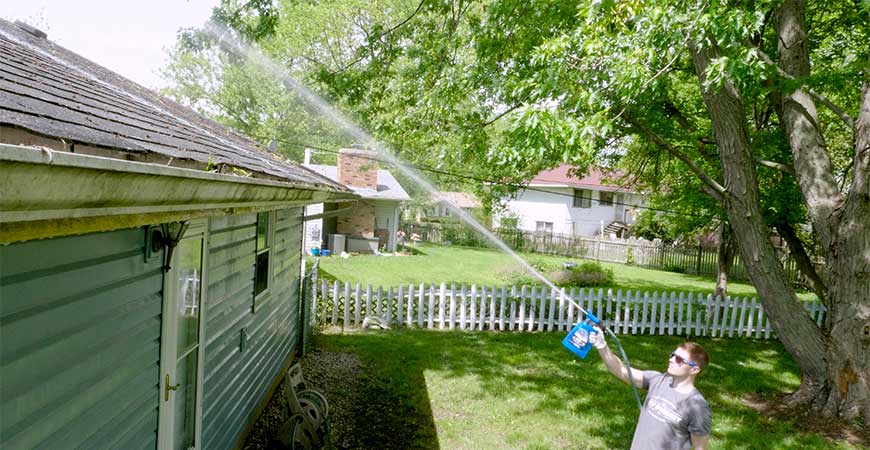
To reach the higher areas of your home, like your roof, attach the jet tip. If you want to cover large surfaces and general applications at ground level, choose the fan tip.
Ensure to apply Wet & Forget Xtreme Reach™ Hose End on a windless day for optimal reach and to reduce any overspray.
When you are ready for application, turn your water spigot on and aim the hose end towards the surface you want to apply your product to.
Turn the black dial counterclockwise all the way to the “ON” setting and spray in a sweeping motion from side to side. The dial can’t be turned any further past the “ON” setting.
If you plan to treat your roof, apply the product by starting at the top of your roof. Then work your way down until you have covered the surface all the way to the bottom.
Once you have finished applying Wet & Forget Xtreme Reach™ Hose End, turn the dial to the “OFF” setting. Turn your garden hose off. You then can remove the Xtreme Reach™ Hose End nozzle from your garden hose.
Do you have leftover Wet & Forget products? Not to worry! Wet & Forget Xtreme Reach™ Hose End has an unlimited shelf life, so it never expires!
We recommend applying the product in the early morning before the sun has a chance to heat the surface. This will help to avoid any rapid evaporation.
It is best to use Wet & Forget when there will be no forecasted rain for at least 4-5 hours. Also, try to apply the product on a cooler day with no wind.
Click here for frequently asked questions about Wet & Forget Xtreme Reach™ Outdoor Hose End.
You can store any leftover product until the next time you need it. It will work just as well as if it was brand new.
Here are some additional tips for removing black and green algae and cleaning your roof.
To learn more about Wet & Forget Outdoor products click here.


